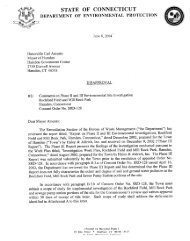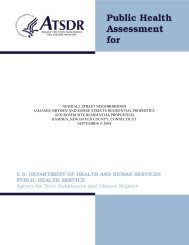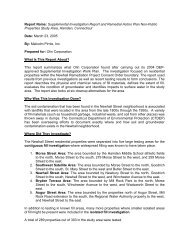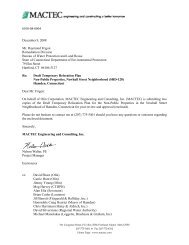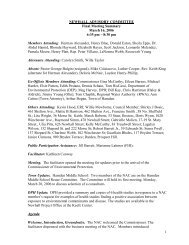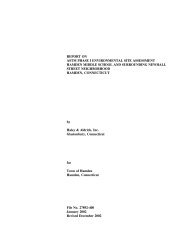Remedial Action Plan - Rochford Field - Newhall Remediation Project
Remedial Action Plan - Rochford Field - Newhall Remediation Project
Remedial Action Plan - Rochford Field - Newhall Remediation Project
You also want an ePaper? Increase the reach of your titles
YUMPU automatically turns print PDFs into web optimized ePapers that Google loves.
The 4.84 acre <strong>Rochford</strong> <strong>Field</strong> is a large grassy area that occupies the block bordered by <strong>Newhall</strong> and<br />
Newbury Streets to the west and south, respectively; Winchester Avenue to the east and Mill Rock<br />
Road to the north. A chain link fence surrounds the recreational facility, which includes baseball<br />
fields, dugouts, backstops, and bleachers. A concrete sidewalk surrounds the outer edge of the<br />
property.<br />
Groundwater underlying the subject site was historically classified as “GAA” by CTDEEP; a “GAA”<br />
classification indicates that the water resource is regulated for potential use as a public drinking water<br />
supply. In 2005, CTDEEP reclassified a portion of the property “GB”; a “GB” classification indicates<br />
that the water resource is not intended to be suitable for use as a drinking water supply without prior<br />
treatment. Both the “GAA” and “GB” groundwater classification areas are shown on Figures 2A and<br />
2B. A public water supply system is used to supply potable water to area residences and businesses.<br />
1.3 Overview of Investigations<br />
In 2001, Haley & Aldrich performed a Phase I Environmental Site Assessment (Phase I ESA) of the<br />
Hamden Middle School and surrounding <strong>Newhall</strong> Street Neighborhood, which included <strong>Rochford</strong> <strong>Field</strong><br />
and Mill Rock Park. The purpose of the Phase I ESA was to evaluate site history, existing observable<br />
conditions, current site use, and current and historic uses of surrounding properties to identify the<br />
potential presence of Recognized Environmental Conditions (RECs). During the Phase I, Haley &<br />
Aldrich identified several RECs and contaminants of concern (COC) for the subject site. These RECs<br />
and COCs are detailed in our April 2002 “Report on ASTM Phase I Environmental Site Assessment<br />
Hamden Middle School and Surrounding <strong>Newhall</strong> Street Neighborhood, Hamden, Connecticut”<br />
In addition to Haley & Aldrich’s 2001 Phase I ESA, CTDEEP and Metcalf & Eddy (M&E) conducted<br />
environmental evaluations of <strong>Rochford</strong> <strong>Field</strong> for the Town of Hamden between 2000 and 2001. The<br />
previous assessments are described in detail in the Haley & Aldrich Phase I ESA report and briefly<br />
summarized below. Locations of the previous explorations are shown on Figures 2A and 2B.<br />
<br />
<br />
<br />
In December 2000, CTDEEP drilled 14 geoprobe explorations in <strong>Rochford</strong> <strong>Field</strong> (SS-21<br />
through SS-34) to depths ranging from 4 to 12 ft below grade; temporary microwells (SS-21,<br />
SS-24, SS-27 and SS-30) were installed in four of the explorations. CTDEEP submitted<br />
composite soil samples (0 to 4 ft depth) for chemical analysis for extractable total petroleum<br />
hydrocarbons (ETPH), total lead, arsenic, thallium and mercury, leachable metals (by SPLP)<br />
and semi volatile organic compounds (SVOCs). Groundwater grab samples from microwells<br />
SS-21 and SS-27 were tested for cyanide, volatile organic compounds (VOCs), SVOCs, and<br />
metals.<br />
In January 2001, CTDEEP collected 14 additional shallow (0 to 6 inches) soil samples (RF-21<br />
through RF-34) from the same locations as SS-21 to SS-34 (December 2000).<br />
In March 2001, CTDEEP conducted additional chemical testing of shallow soil samples for<br />
arsenic at locations designated RF-35 to RF-44. CTDEEP also collected shallow soil samples<br />
(0 to 2 inches and 2 to 6 inches depth) from 20 locations (RF-45 to RF-64) for screening using<br />
X-ray Fluorescence (XRF) and laboratory analysis for arsenic (0 to 2 inch depths only).<br />
2



